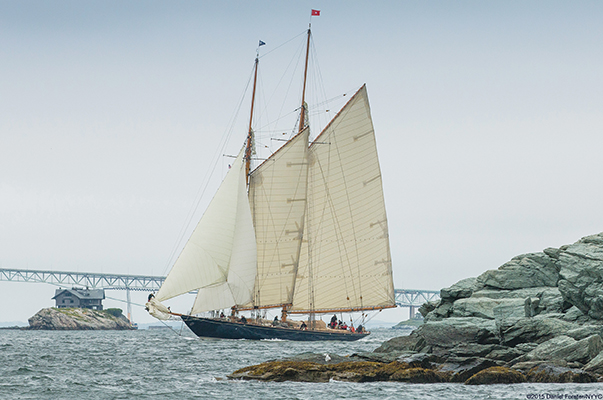The Transatlantic Race pits magnificent crews and their sailing machines against the mighty Atlantic (published September 2015)
The Transatlantic Race is one of the most storied ocean races of all time and this latest event that recently finished off England’s southwest coast was no different. From the mighty Comanche, Jim Clark’s massive carbon monohull, to Dorade, a wooden classic that won the race in 1931, and a whole bunch of boats in-between, it was an impressive showing for the 30th running of the event.
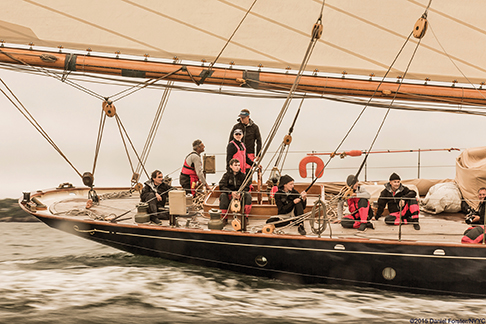
The first Transatlantic Race took place in 1866, the result of a wager between a number of sailors who had been debating the merits of a centerboard design compared to a full keel design. They were at a dinner at the New York Yacht Club, the debate got heated, as these things tend to do, and before the meal was over there was a wager on the table. George and Frank Osgood owned Fleetwing which sported a full keel. At 107-feet long it was three feet shorter than Pierre Lorillard’s Vesta, a centerboarder with a draft of 15-feet when the board was down. Size and handicap were of no issue. The wager was $30,000 each, winner taking all. They would start off the Sandy Hook Lightship at the entrance to New York harbor and race to England. They were joined by a third entry, Henrietta, also a full keel design owned by James Gordon Bennett Jr. They named the event the Great Race and set December 11, 1866 as the start date.
The three boats left New York with a strong westerly push which carried them all the way across the Atlantic in a nail-bitingly close race with all three boats finishing within hours of each other on Christmas Day. Henrietta won the race with Fleetwing beating Vesta by a mere 40 minutes, but their victory over Vesta came at a great cost; a few days earlier gale force winds had rolled Fleetwing and they lost six crew members overboard.
THE START
It was against this backdrop of history, plus many more stories of close racing and bravery, that the latest fleet set off from Newport, Rhode Island in a staggered start. Race organizers were looking for a close finish in England and therefore gave the smaller, older boats a head start with the first wave leaving Newport on June 28 in unseasonably cool weather. An intense low-pressure system rolling up the Atlantic Coast had been threatening to delay the start but the worst had passed through by start time and the thirteen boats headed off in moderate conditions. Aboard the largest yacht in the race, the 125-foot Herreshoff design Mariette of 1915 things were bumpy.
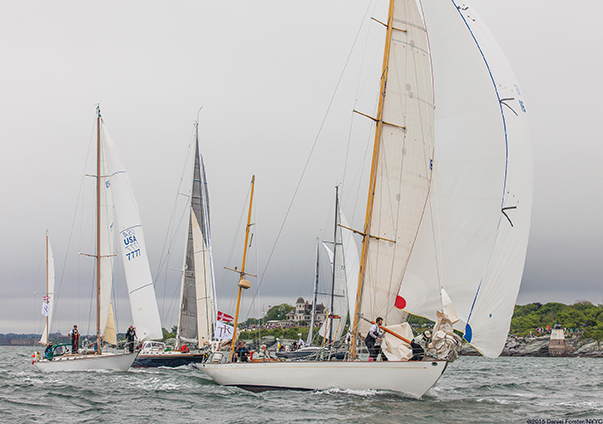
Transatlantic Race 2015
“The first night was difficult; there was not much wind at all and a big lumpy seaway with everything clanking around,” reported Charlie Wroe, the captain. Also starting in the first wave was Dorade, a sentimental favorite of just about everyone competing. Dorade was designed by Olin and Rod Stephens and was a breakthrough design for its day. The brothers along with their father raced on board and won the race. When they returned to the US aboard the ocean liner Homeric the ship was met and the crew whisked away for a ticker tape parade down Broadway, such was the importance of their victory.
While the IRC Class 4 racer/cruisers settled into the rhythm of life at sea, the second wave set sail on July 1. Rather than being on the water, the race committee was stationed at the historic Castle Hill lighthouse and the beautiful coastline of Rhode Island lent a stunning backdrop to a picture perfect start. The fleet of 20 boats was an eclectic mix of Class 40’s, some out-and-out racers in the IRC Class 2 Division, and some racer/ cruisers in the IRC Class 3 Division. All eyes were on Lucky, the 63-foot Reichel Pugh design favored to win with Charlie Enright and some of his crew from Team Alvimedica on board fresh from their win of the last leg of the Volvo Ocean Race. Also competing in the racing division was the 76-year old Sir Robin Knox-Johnston aboard his Open 60 Grey Power. RKJ, as he is affectionately known, was the first person to sail around the world solo, nonstop and does not seem to be slowing down in his golden years.
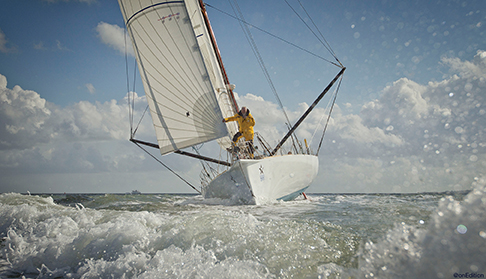
The forecast was for a quick start and for the first time tactical choices for the first half of the race were limited by the ice exclusion zone which extended quite far south. In previous races, you could either follow the great circle course by heading north, follow the rhumb line, or dive south to pick up the slingshot effect of the Gulf Stream. All the second start boats chose to dive south in search of the warm current and a small low pressure that was forecast to meet them there. Lucky was first into double bonus territory and took an early lead, but the real racing was among the Class 40’s. The five boats in their class were in a tight race with just a handful of miles separating them. Aboard Toothface Michael Dreese reported, “We are currently waiting for a pretty good low pressure system to kick our butts. At the moment we are sailing fast in about 26 knots of wind with the forecast to build to 35 knots later tonight.”
Ahead of the Class 40’s, Mariette of 1915 was relishing the conditions in a case of the rich getting richer. Multiple circumnavigator Halvard Mabire was navigating and shared his thoughts on what was his fortieth transatlantic crossing. “When compared with modern boats there are still some things in common, since the wind is still the wind, sails are sails, and the ocean is still the ocean, but certain maneuvers are very different. There are a number of sails which require crew to go aloft and execute the same maneuvers as the seaman of old who made sailing legendary by being able to climb aloft in the rigging no matter what the conditions, the angle of heel, or the sea state.” The 100-year old schooner was dishing up yet another set of fond memories for the fortunate crew.
The Transatlantic Race has always been a place for records to be set and broken. In the 1905 edition the 227-foot schooner Atlantic set a new record days run of 341 nautical miles bettering the previous record of 328 nautical miles set by Dauntless. This year new records were also set. The third start was on July 5th and was another showdown between the 100-foot Comanche, and Rambler with the Juan K designed Rambler measuring in 12 feet shorter than Comanche. Still with a crack crew on board including multiple veterans of the Volvo Ocean Race there was hope that Rambler might be able to match Comanche boat for boat, but it wasn’t to be.
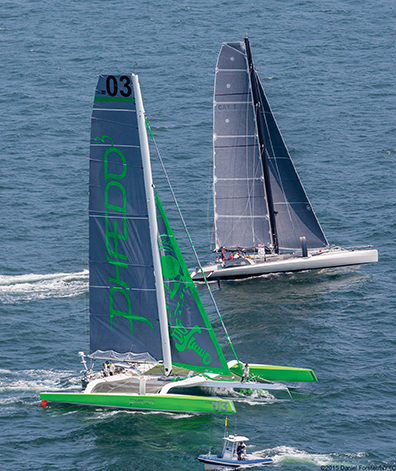
Starting with the giants was another showdown between two multihulls also featuring crack crews. The fastest man on water Paul Larsen was racing on board the 63-foot Paradox while Brian Thompson, who was part of the team that smashed the Jules Verne record was skippering the 70-foot trimaran Phaedo3. With picture perfect weather for the start all four boats were logging speeds in the high 20-knot range long before they were out of sight of land, but the fast pace was short-lived. Two days into the race they were becalmed in a private area of high pressure. Phaedo3’s navigator Miles Seddon lamented. “It’s been pretty hard work the last few days. A high pressure system blocked our path to the ice gate. We’ve worked hard to keep the boat going, often ghosting along at two knots, searching for the extra 10th of a knot to keep ahead of the rest.”
Aboard Comanche skipper Kenny Read was also feeling the pain. “Long and frustrating day both yesterday and all last night but we got the fat bottomed girl moving a bit better in light air. Yes we were drifting at times.”
WIND AT LAST
Fortunately for the late starters the new breeze filled in they took off in search of a low pressure system that would give them a fair ride to England. Five days into the race they found just what they were looking for.
A corridor of strong southwesterly winds filled in and straddled the entire North Atlantic to provide perfect record breaking conditions and Ken Read and his crew on Comanche took full advantage covering 618.01 nautical miles in a 24-hour period. The previous record was 596.6 nautical miles set in the 2008-9 Volvo Ocean Race by the crew on board Ericsson4. Comanche’s average speed of 25.75 knots was enough to demolish the old record.
Read was ecstatic. “As a group, we are very excited about it. Our top speeds were into the mid-30s a bunch of times. It is not like you are surfing down a wave, you just go….fast. The boat is amazing. You sail it heeled over and it feels like you are right on the edge, but when you grab the wheel you are in control. The boat is a phenomenal piece of machinery.” The record still has to be ratified by the World Sailing Speed Record Council.
The finish line for the Transatlantic race is the iconic Lizard Point, a rocky outcropping on the southwest corner of England. In a new twist to the race the boats would cross the finish line which would also serve as the start line for the second part of the crossing; the Coastal Race which would finish off Cowes on the Isle of Wight. As the racers approached the end it was Lucky, the northernmost boat in the fleet that looked poised to take victory. From onboard Jesse Fielding reported, “After 2,400 miles of brutal cold and high winds it has come down to the last 400 nautical miles to determine who is first to The Lizard and overall winner of the 2015 Transatlantic Race. We are ‘one and in’ from our current position. The plan is to keep ripping along the layline and let the header take us down to the finish.”
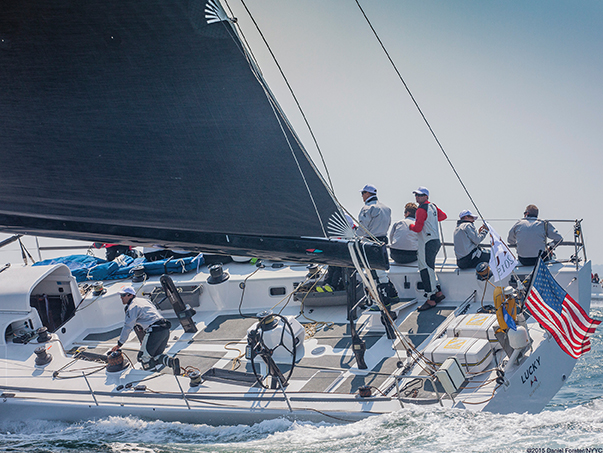
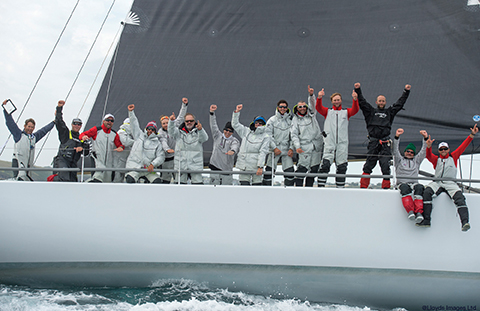
In hot pursuit of Lucky was the 100-foot Nomad IV, but Lucky was able to hang on to their lead and took overall line honors. The much larger Nomad IV had been plagued by technical problems including losing their hydraulics just two days into the race. They were closely followed by Mariette of 1915, the biggest, heaviest and oldest boat in the race. Mariette of 1915 had led the fleet for the majority of the race managing to get the 165-ton schooner up to a top speed of 17.8 knots. “All boats have their limitations,” said skipper Charlie Wroe. “But you get on a boat like Mariette and she gets a rumble on and you feel it from your toes—it is pretty special.”
Despite being becalmed for two days the fastest crossing was by Phaedo3 who managed the 2,800 nautical mile course in seven days, two hours, four minutes, nine seconds. They in fact managed to sail 2,442 nautical miles in just four days once the wind filled in and clocked a top speed of 41.2 knots. Their longest 24-hour run of 652 nautical miles lent some perspective to the multihull versus monohull debate; Phaedo3 is 30 feet shorter than Comanche.
FOR THE RECORD
It’s always a good event when almost all your competitors finish and the 2015 Transatlantic Race was no exception with just five boats of the 37 boat fleet retiring. Mariette of 1915 won the IRC Class 4 division with the sentimental favorite Dorade finishing second. The consolation for Dorade; they knocked more than a full day off the time set back in 1931 by the brothers Stephens and clocked a top speed of 18.7 knots. Not a bad surf for an 85-year old lady.
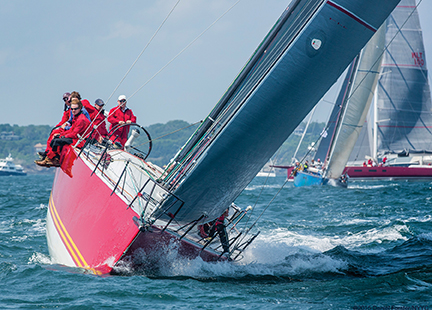
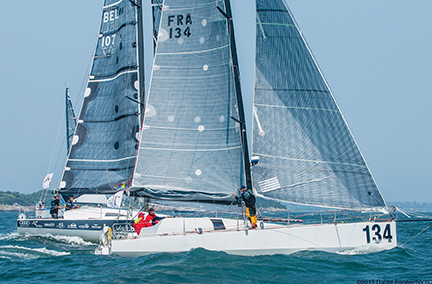
The Class 40 division was won by Stella Nova skippered by Burkard Keese. Lawrence Huntington’s Snow Lion won the IRC Class 3 while Rambler corrected out ahead of Comanche to win the IRC Class 1 Racing Division.
For a race like the Transatlantic Race, you are always chasing ghost ships, legends from the past that lend a timelessness to ocean passages. Many sailors out there must have spared a thought to the legendary skipper Charlie Barr who drove the 227-foot three-masted schooner Atlantic across the pond from New York to Lizard Point in the 1905 race in a time of 12 days, four hours, one minute, 19 seconds, an outright racing record that stood 75 years.
In a full gale halfway across Barr was pushing so hard that water ran ankle deep in the fancy staterooms below deck while guests hung on for dear life. Atlantic’s owner, Wilson Marshall, berated Barr, and demanded that he heave-to. Instead Barr lashed himself to the wheel and told Marshall, “You hired me to win…” Legend has it that after Marshall went below, Barr called for more sail. While the stories from the 2015 race may be tame by comparison they are no doubt special in the minds of all who competed.
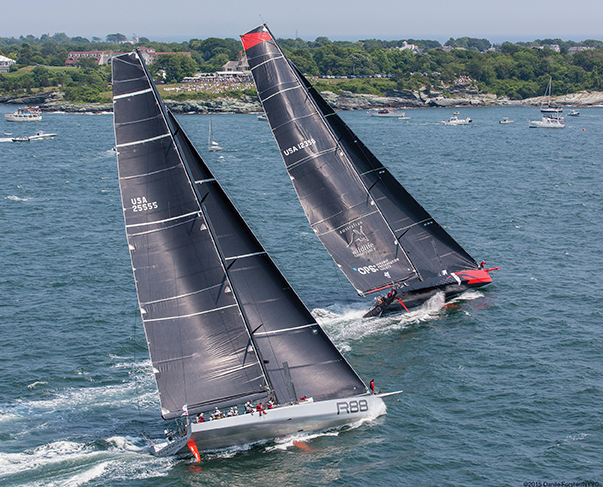
Brian Hancock is a sailmaker, author, lecturer and veteran offshore sailor and racer. He lives in Marblehead, Mass.

















